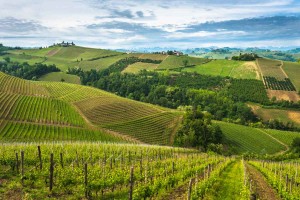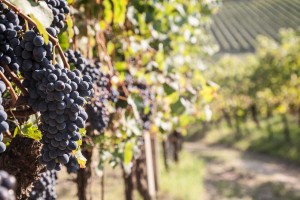
©Bigstock.com/javarman
When Italy was awarded its 50th World Heritage Site in June 2014, it wasn’t one of the many amazing sights, but, for the very first time, a cultural landscape deserving of utmost protection. The vineyard landscapes Langhe-Roero and Monferrato in Piedmont are home to some of the country’s finest wines. Hundreds of municipalities run through this continuous hilly landscape with countless vines, small farms, villages, churches and castles. Five vineyard landscapes and one picturesque castle with a total area of over 10,000 hectares make up one of the country’s most amazing World Heritage Sites.
Nature meets human influence
The term “cultural landscape”, one of the deciding factors for the UNESCO World Heritage Site declaration, describes a sort of co-operation between nature and man. While some changes to the existing scenery were made, particularly to establish the infrastructure necessary for winegrowing, those interventions were as gentle as possible in order to preserve the region’s natural beauty. Hill after hill, vineyard after vineyard, village after village now awaits you with a total catchment area of over 76,000 hectares.
The region itself is situated in southern Piedmont between the river Po and the Ligurian Apennines. Scientists found pollen dating back to the 5th century BC providing clues on the area’s highly fascinating history. Etruscans and Celts established ties here and exchanged goods while, in Roman times, Pliny the Elder and the Greek historian Strabo praised the outstanding winegrowing culture. Some Celtic and Etruscan terms, particularly those relating to wine, are still part of the regional dialect. You will hardly be surprised to hear that the south of Piedmont between Langhe, Roero and Monferrato was responsible for many a technological revolution in wine production over the centuries.
Langa del Barolo
Now it’s time to explore the six parts of this UNESCO World Heritage Site one-by-one. Our first stop is Langa del Barolo. It is home to the durable Barolo, one of the best and most famous wines in the world. This dry, robust red wine is stored for around 38 months until it gains its ruby red colour and intense aroma. The village Barolo itself welcomes you with a museum of corkscrews and the glorious Falletti Castle with a wine museum and enoteca. Roddi, this quaint village nearby, has a special university for truffle dogs. Finally, we recommend a trip to La Morra. You will be enchanted by many a charming baroque building and the grand view across a veritable sea of rolling hills.
Castello di Grinzane Cavour
Five vineyard landscapes and one castle – a rather unusual UNESCO site, you’ll probably agree, but the castle in the municipality of Grinzane Cavour most certainly has a special appeal. The exact origin of this imposing box-type building is unknown – experts date it back to the 13th century, the tower was built around 1350. In fact, the castle survived the centuries excellently and was only mildly altered over time. Its massive keep stretches across an entire wing flanked by extensive defensive fortifications. Your tour must include Sala delle Maschere. 157 panels, likely from the early 16th century, splendidly depict coats of arms and animals. It goes without saying that the Castello has its own wine cellar.
The hills of Barbaresco
This dry red wine is extracted from the Nebbiolo grape around the villages Barbaresco, Neive and Treiso. It matures late and is usually only harvested in October when the vineyards are covered in fog (Italian: “la nebbia”), hence the name. Maturing for at least 26 months, the equally ruby red Barbaresco wine is known to impress with its dry, full-bodied taste. On clear days you can even see the mountains that hosted the alpine skiing competitions of the 2006 Olympic Winter Games from the hills of Barbaresco. Don’t miss out on a trip to Treiso, one of Italy’s most beautiful villages.
Nizza Monferrato and Barbera

©Bigstock.com/elifranssens
The roots of this extremely adaptable and high-quality grape variety can be traced back to the 13th century. While this high-yielding grape is grown all across Italy today, it still tastes best in Nizza Monferrato. This fine wine with protected geographical designation of origin may only be grown in 18 municipalities around this very town. The mix of hot summer days and cool nights creates a special blend of fruitiness and acerbity reflecting the unadulterated grape character. If you happen to have a bit more time at hand, we recommend a neat little town walk with a peek inside the old 14th or 15th century town hall and the colourful Palazzo Crova.
Canelli and Asti Spumante
When it comes to sparkling wines, the province of Asti is your prime destination. Canelli, a municipality with around 10,000 inhabitants, is widely regarded as the stronghold of Asti Spumante, but it is also home to many other wines, such as Barbera, Moscato, Dolcetto, Freisa or Cortese. It goes without saying that Canelli is one of the world’s most important wine towns. The vast sparkling wine growing area stretches around the tremendous medieval castle, which was destroyed in 1617 and rebuilt as an astounding villa during the 1930s. The fine, aromatic Asti Spumante with its straw yellow to pale golden colour is known for its distinctly delicate aroma and balanced flavour. Its roots actually lie in the French city Reims. Wine pioneer Carlo Gancia was introduced to the process of producing champagne there and brought all the knowledge necessary for making the delicious sparkling Asti wine to the region in 1865.
Infernòt of Monferrato
Our final stage takes you to the region of Basso Monferrato, part of one another significant Italian winegrowing areas. Embedded in the rolling hills hardly exceeding 400 altitude metres, ancient, deep wine cellars were carved directly into the rock. There’s hardly any light and no aeration whatsoever in these Infernòt, the Piedmontese name for these hand-dug caves. The region’s best wines, such as Barbera and Dolcetto, mature here without any disturbance. You absolutely should participate in one of the many guided tours leading you through several of Montferrato’s most beautiful wine caves.
Don’t miss out on this unforgettable tour through one of the world’s most significant winegrowing regions! Look forward to picturesque villages, glorious hilly scenery, friendly people and divine wines with an amazing mix of nature and technology, art and culture. Time to book your trip to southern Piedmont!